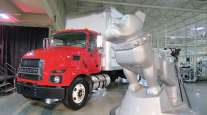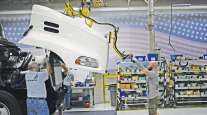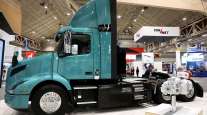Staff Reporter
Mack Trucks Showcases MD Electric Truck in California

[Stay on top of transportation news: Get TTNews in your inbox.]
SONOMA, Calif. — Mack Trucks showcased its medium-duty MD Electric truck Oct. 30 through Nov. 1 at Sonoma Raceway.
The MD Electric is Mack Trucks’ second battery-electric vehicle. The first was the LR Electric refuse truck, unveiled in March 2022.
Mack Trucks introduced the MD Electric in March 2023. Its diesel-powered MD sibling was introduced in 2020, after an almost two-decade Mack Trucks absence from the medium-duty market.
Sweden’s Volvo Group AG, Mack Trucks’ parent company, wants 35% of the vehicles coming off its global production lines to be electric by 2030. Volvo Group expects 100% of the vehicles coming off the production line to be fossil-fuel free by 2040.
Mack Trucks’ showcase for the MD Electric — to reporters, customers and dealers — took place at one of five road courses to host a NASCAR weekend this season. NASCAR debuted at Sonoma in 1989. The road course features more than 160 feet of elevation change from its highest point (Turn 3a, 174 feet) to its lowest point (Turn 10, 14 feet).
The charge up the hill to Turn 3a is akin to the steep inclines delivery trucks tackle in the track’s nearest major city — San Francisco.
And the first item to note about the MD Electric is how responsive the acceleration is; there’s instant power, good for any racetrack elevation gain or delivery to a hilltop bar.

Reporters took part in a ride and drive for the MD Electric. (Keiron Greenhalgh/Transport Topics)
Braking was easy when coming out of Turn 3a downhill to a sharp right-hander. There are three modes of regenerative braking as well as the air brake. Any jitteriness was due to driver competence.
The truck is quiet, and its layout is simple.
As reporters drove around the track, there was a tight hairpin heading into the start/finish straight, what’s known as Turn 11 on the road course. The hairpin comes after a long run down the hill through turns 7-10.
The MD Electric was responsive and easy to guide through the concrete barrier-lined corner typically negotiated by much smaller vehicles.
“Operators like the responsiveness,” said Scott Barraclough, Mack Trucks’ senior product manager of e-mobility, in providing some feedback on how testing had gone before the track day.

Barraclough says the MD Electric's chassis and body attachments will feature J bolts rather than U bolts. (Keiron Greenhalgh/Transport Topics)
The MD Electric is available in Class 6 and Class 7 ratings. The Class 6 option has a gross vehicle weight rating of 25,995 pounds, and the Class 7 model has a GVWR of 33,000 pounds.
The truck has a 19,400-pound maximum payload. The Class 7 chassis weight is 13,600 pounds, some 3,000 pounds heavier than the MD 7, while the Class 6 chassis is 1,000 pounds heavier than its counterpart. It is offered in dry van/refrigerated, stake/flatbed and dump formats.
The MD Electric’s chassis and body attachments will feature J bolts rather U bolts, as they are easier to fit and have less chance of rubbing against wires, Barraclough said.
The batteries are located behind the cab. The company is using Sea Electric off-the-shelf batteries rather than a proprietary battery, unlike Daimler Truck North America, whose Freightliner eM2 began production in recent days at the company’s Portland, Ore., plant.

Fotopoulos
Mack Trucks chose the lithium-nickel-manganese-cobalt oxide chemistry because of the higher energy density and lower weight, George Fotopoulos, e-mobility business unit leader, said during an Oct. 30 presentation to reporters. “We evaluated many batteries” before choosing the nickel-manganese-cobalt option, he said.
The MD Electric can be charged using both alternating current and direct current hookups. Using an AC power source, the truck can be fully recharged in six to 11 hours; using an 80 kWh DC hookup, the truck is ready to go again in 100 to 150 minutes, Fotopoulos said.
Mack Trucks expects 70% of the MD Electrics on the road to be box trucks, be that dry van or refrigerated. Around 80% of Mack Trucks’ medium-duty customers drive less than 250 miles per day, Fotopoulos said, noting that charging during the workday would be available and that regenerative braking would aid range too.
Volvo's Keith Brandis and Eric Bond take an in-depth look at how the company's SuperTruck 2 improves freight efficiency. Tune in above or by going to RoadSigns.ttnews.com.
“This truck has a one-to-one capability” when matched against internal combustion engine competitors, Fotopoulos said. The battery comes in two configurations: 150 kWh and 240 kWh, which have corresponding maximum ranges of 140 miles and 230 miles. Those ranges were calculated on a diminishing load basis, he said, adding that deviations from ambient temperatures would also have to be included in calculations.
All told, the three-year total cost of ownership is cheaper than that of a diesel counterpart, he said.
Mack Trucks started taking MD Electric orders in the summer, Fotopoulos said, adding that the production program is not yet full for 2023. The first MD Electric deliveries will be made in the fourth quarter of 2023.
“We took care of the heavy-duty lift [with the LR Electric] and now we’re taking care of the medium-duty lift,” he said.
Mack Trucks also showcased diesel medium-duty trucks in September at another NASCAR road course — Wisconsin’s Road America.
Volvo Group plans to meet its 2040 goals through a combination of battery-electric vehicles, fuel cell electric vehicles and internal combustion engine vehicles that use bio or renewable fuels.
Want more news? Listen to today's daily briefing below or go here for more info:





